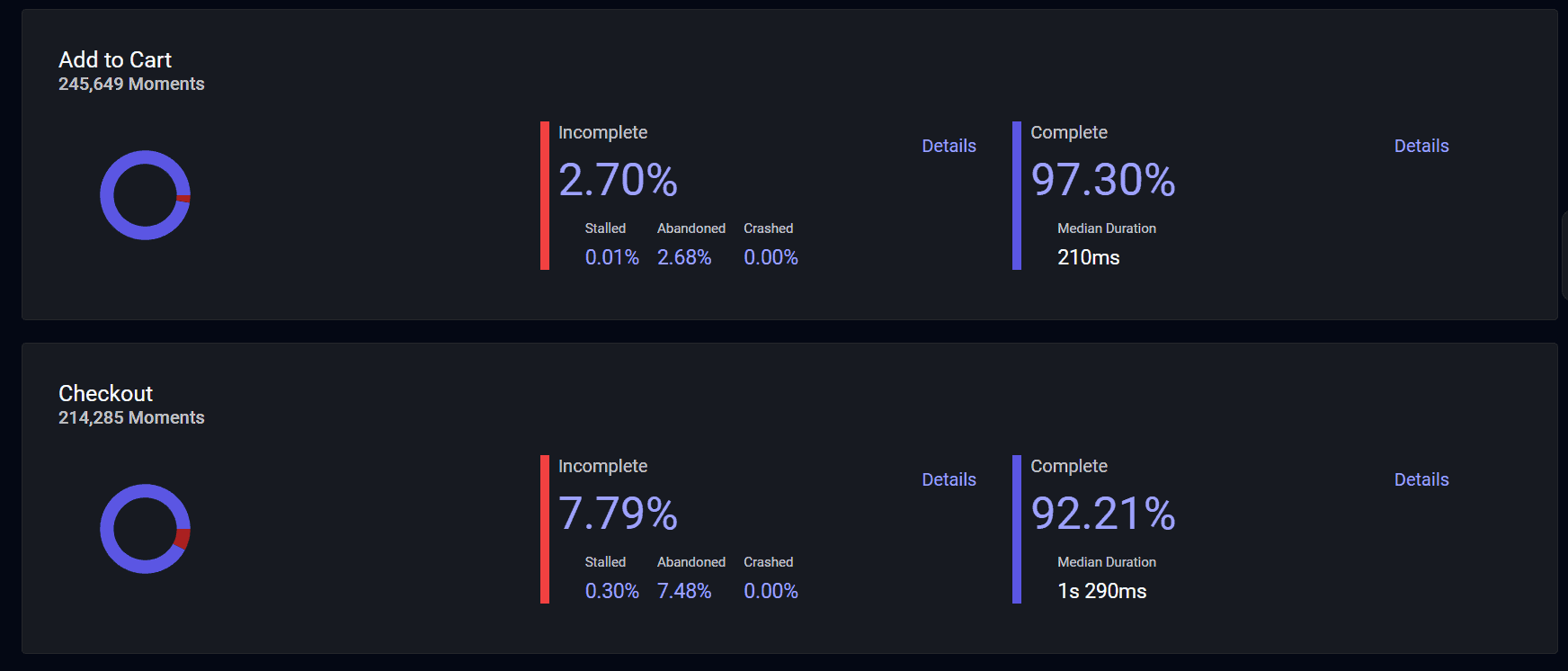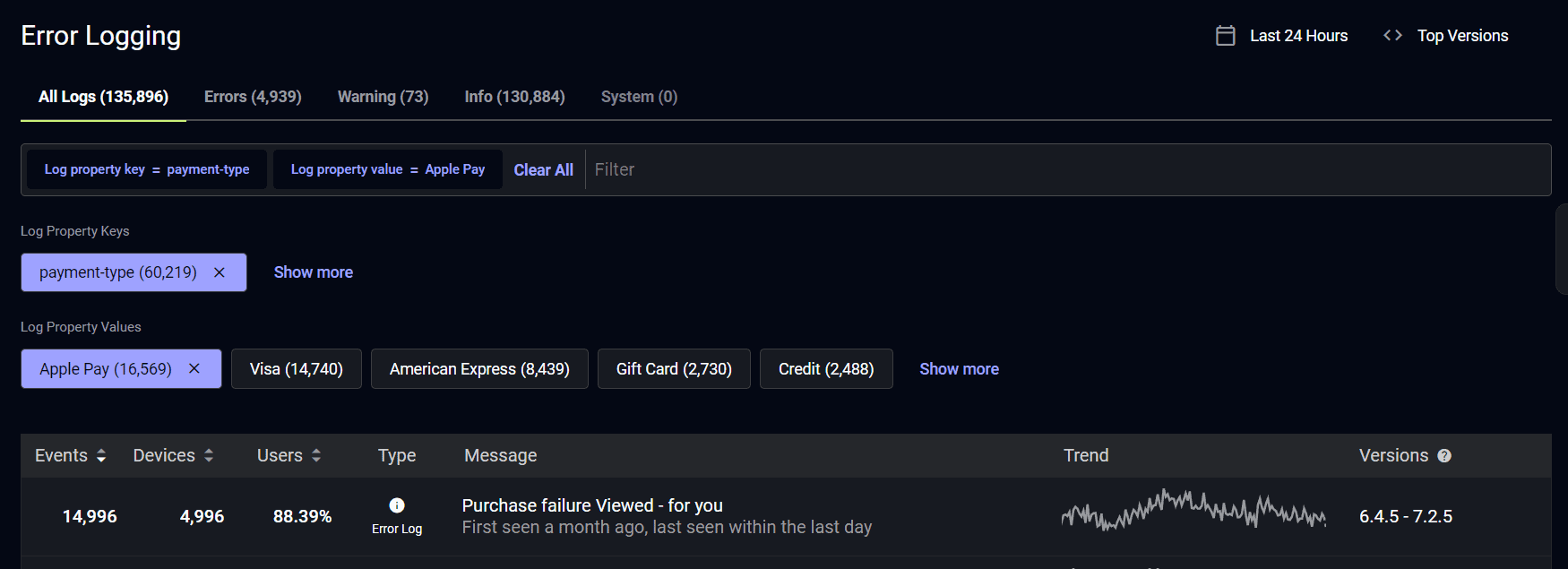In mobile, no two sessions are identical, and the same goes for users. Users have vastly different usage patterns and derive varying degrees of value from your mobile app. It’s important when making key decisions to understand which users are affected and how valuable they are to your business. That way, stakeholders can drill down to specific user segments to make optimizations based on their needs.
In this post, we’ll cover:
- What are user personas?
- Why it’s important to monitor user personas
- How to create effective user personas
- The various benefits of user personas
- What visibility do mobile teams need to effectively monitor user personas?
What are user personas?
There are many ways you can monitor your mobile app users:
- By which ones use certain app versions
- By which ones are in certain countries
- By which ones have certain devices
These classifications are incredibly helpful, but they don’t tell you much about where those users are in the adoption of your mobile app. For that, you need to bucket users into personas so that you can view where they share common usage patterns, frustrations, etc.
At its simplest definition, a user persona is a section of your userbase that has a common goal and/or trait that represents the desire of a larger group of your app users.
Let’s cover the types of user persona that could exist for a subscription-based health and wellness mobile app:
- First time user: They downloaded the app and launched it for the first time. You always want your first time user experience (FTUE) to be seamless. This is why your understanding of this experience is crucial to avoid people churning on day 1.
- Free trial user: They registered for an account and want to try out your product.
- Basic membership subscriber: They enrolled in your basic membership and they are an average user of your app.
- Premium membership subscriber: They’ve enrolled in your higher tier and/or long-term membership.
- Frequent user: Do they launch the app several times per day? Where do they spend their time?
- Heavy user: Do they download several videos, upload several, leave many comments, etc. What are the friction points that prevent them from getting the most usage out of your app?
Why it’s important to monitor user personas
Your users are the lifeblood of your app. Without them, you wouldn’t have a functioning product. Each of your users are going to care about different things because they use your app in unique ways. If you want to spot every way to optimize your mobile app for everyone, then it’s vital to understand common use cases. Otherwise, if you look for aggregate metrics across your entire userbase alone, you will miss frustrating experiences that don’t affect the majority of your users.
In addition to this, different product and engineering stakeholders will focus on building features for specific parts of the app. Having their sights focused on the right issues is important. They want to know they’re building what those users will find valuable.
Let’s consider your first time user. They’ll probably never run into the same problems that your power users will. This is why you need monitoring that provides insights for this group alone. You don’t want to lose a first time user that has the potential to become a power user due to a lack of insight into their experience.
The ability to track user onboarding drop off is vital. This ability allows you to note which problems directly lead to user abandonment so your team can fix them. Tracking a key user moment also allows you to note which features your power users love and make sure they’re both effective and frictionless.
How to create effective user personas
In the mobile space, you want to cater to a wide range of customers. Here are a few ways to create effective user personas that are tailored to your app no matter the vertical.
Know your target audience
You’re marketing your app to specific types of people. This is why it’s important to know the value you want them to receive from your mobile app. It’s best to have a definitive idea of who you want to use your app and how you want them to use it.
For example, if you’re an e-commerce app, it’s beneficial to know the age range, location, income, spending habits, and app usage that you aim for in a user. Developing a definitive persona regarding all this helps you anticipate user needs and better target potential users.
Understand their motivations
It’s best to understand why users are drawn to your app and what their goals are. From here, you can understand their motivations and figure out how to give them what they need with ease. The “with ease” aspect is one of the most important parts to hone in on.
Let’s expound on that same e-commerce example from above. In this scenario, you’ve identified that your users are 25-40 year olds in the U.S. that make an average of $65k annually. They buy your product once every 3 to 6 months and are motivated by the desire to obtain the item that you sell quickly with both precision and ease. This understanding leads to the right targets. From here, you can begin to track the right metrics.

Your mobile team can then monitor the success rates of users adding to cart, checking out, and more. If any one of these metrics dips below a satisfactory completion rate or the median duration rises too high, the mobile team’s time can be allotted to solving the issue to retain valuable customers.
Identify challenges
Note where your current app users face trouble with the app’s aim. Have your team ask key questions about your users like:
- Do they prefer one feature over the others?
- Do they get stuck when completing purchases?
- Do they prefer to consume content rather than contribute content?
Having a clear definition of the problems your app faces leads to faster solutions.
The various benefits of user personas
Having a clear understanding of your different user personas is beneficial because you can prioritize based on business impact by selecting issues that affect your highest value users.
Identify your yey users
Your best users are your highest value users. Your highest value users are those who frequent your app most and use it over long periods of time. Once you have identified your key users, your mobile developers will understand what issues they should focus on.
For example, Medtronic’s app Touch Surgery had key users that frequently had poor network connectivity. People used the mobile app in hospitals with concrete walls that caused poor WiFi. As a result, the app’s team prioritized removing the blocking and network-heavy processes that slowed the startup time. They also solved network congestion to improve the user experience. This allowed them to retain their most valuable app users.
Prioritize issues and maximize time
Once you know your highest value users, you can begin to prioritize based on issues and maximize the time of your mobile team. One of the best ways to do this is by monitoring your users based on subscription.
An educational platform was able to customize their dashboard to display their users in segments. They segmented free trial users, premium trial users, monthly subscription users, and annual subscription users of their app.

Their goal was to know which course downloads fail and for which segments of users. Their mobile team was then able to hone in on their most valuable demographics of users when improving their in-app experience.
Additionally, an online yoga, mediation, Pilates, and fitness app was able to customize their dashboard to display their users in segments. They segmented free trial users, monthly subscription users, and annual subscription users of their app as log properties to easily check the impact across their errors.

From here, they have been able to target the concerns of their users with the highest possibility of churn (i.e. monthly users), track pain points through error logging, and address these issues as soon as possible. They’ve also been able to tend to the needs of their VIP users (i.e. subscribers) who spend a considerable amount of time and money in their app.
Expand with ease
As your app expands, you’ll want to venture into new markets. If you’re thinking about expanding into new countries, then it’s worthwhile to know how your app works with a new user base and drill into their pain points.
A mobile basketball game app mitigated user acquisition costs through the use of geographic rollouts. They knew from previous app rollouts what their most important performance and stability targets were. In their case, the targets included limiting unhandled issues and achieving the best moment performance. They started in their most cost-effective markets, hit their targets, further developed their app, and then moved into mid-level markets once they were satisfied with their performance. The deep understanding of the needs of their varying user personas allowed them to grow their app in new markets with minimal friction.
Monitor app releases
Your app will grow and evolve over time. If your team runs into an issue after they’ve shipped a bad app release, a simple way to isolate and solve problems is through segmenting in the dashboard by app version. If there is a problematic app release, your team will notice it right away and be able to fix the issue fast.

For example, an app that allows its users to develop habits to stop their alcohol cravings was able to improve their app through the analysis of app releases. They implemented custom dashboards and organized them like in the photo above. Through monitoring this data, they noticed that one of their app releases was causing an 8% failure rate. The ability to analyze specific app releases allowed them to quickly solve a major issue, improve their user experience, and ultimately retain their users.
The value of this type of feature is that it leads your mobile team to important questions like, “Do our most valuable users always upgrade their app?” If the answer is yes, then you know your team needs to focus their sights on keeping your most up to date version problem free.
What visibility do mobile teams need to effectively monitor user personas?
Your mobile team needs the ability to dive into any user session. The ability is needed because you can’t predict the types of issues your user might encounter ahead of time. Due to this, you need to be able to collect insights about user personas and make them actionable through features like:
- Dashboards dedicated to tracking on a team by team basis
- Filtering on dashboards to target the metrics you care about most
- Tracking entire user sessions and key user moments
The pursuit of the high-quality data listed above can be difficult. Luckily, Embrace collects all the user data you need to make informed decisions regarding your app because we’re a mobile-first platform that provides insight into every user complaint. With Embrace’s dashboard customization features, you can look at specific segments of users to understand which factors affect certain users, how these users affect your business, and what issues should take priority. This improves your app, helps you remain proactive, and keeps you competitive in the marketplace.
If you’d like to see how Embrace’s data driven toolset can revolutionize how you build, test, monitor, and optimize your mobile apps, please reach out to our team. We’re passionate about providing mobile teams with the best monitoring available. Request a demo today.

